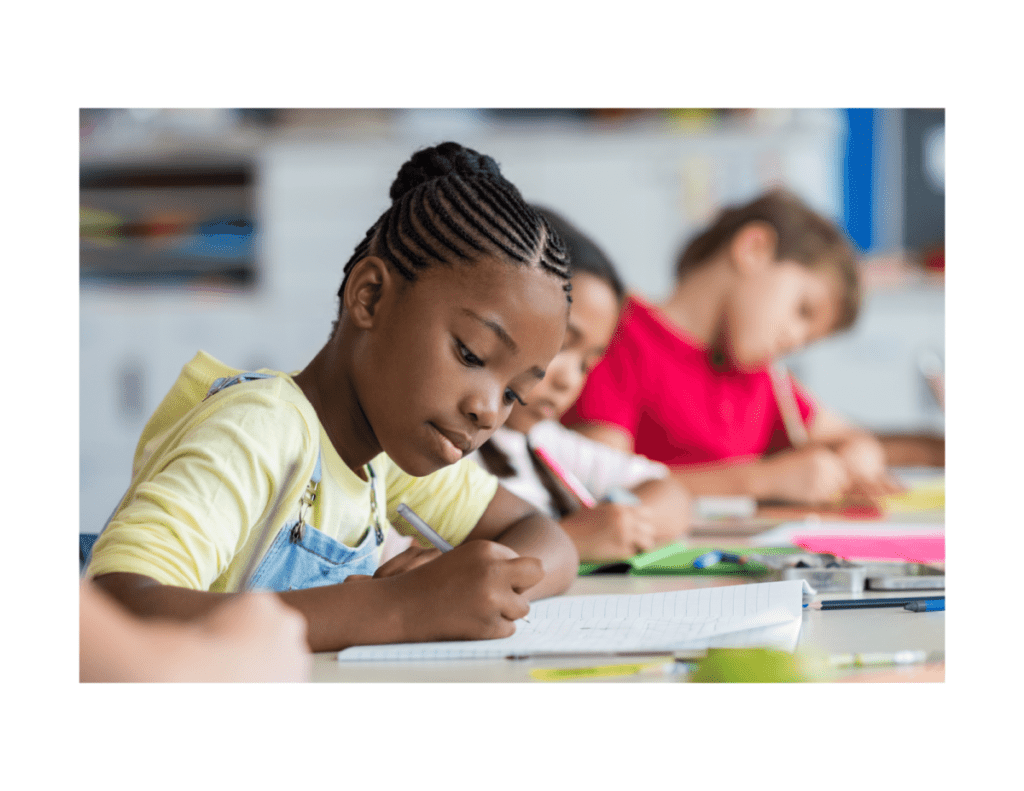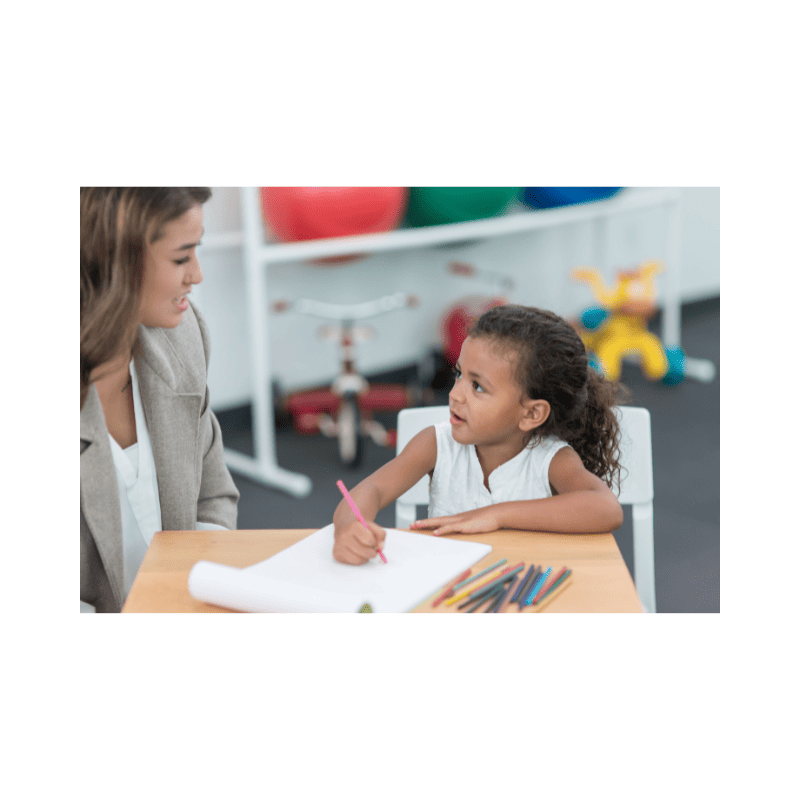As part of my job as a school-based occupational therapist, I am frequently asked to evaluate students to determine their need for services. Identifying any deficits hindering the student’s performance is essential to compile a treatment plan to help the student succeed in school.
These are the seven areas most commonly affected by fine motor delays in children and what occupational therapy practitioners can help with.
- Dressing Skills and Clothing Management
- Coloring
- Cutting with Scissors
- Handling Classroom Manipulatives and Small Objects
- Pencil Grasp, Pencil Control, and Handwriting
- Opening Containers
- Managing and Organizing School-Related Tools and Materials
Dressing Skills and Clothing Management

Dressing skills and clothing management are an integral part of activities of daily living (ADLs). Deficits in this area refer to the inability or difficulty with self-dressing. A child may have trouble donning (putting on) or doffing (taking off) their socks or shirt, buttoning, putting on shoes and tying shoelaces, or zipping up their jacket.
Fine motor skills are a prerequisite for mastery in self-dressing. Let’s take, for instance, the act of tying shoelaces. When children tie their shoelaces, they get down close to the ground. They must demonstrate reasonable balance and postural control, keeping their trunk aligned and shoelaces within the line of sight.
Furthermore, they must display excellent head control to see what they are doing. Arms must be strong and steady to facilitate the hands’ intricate movement patterns to complete the activity successfully.
I am sure that by now, you get the picture. There is a lot that goes into this activity and all clothing management activities. Other essential skills required for these tasks are bilateral use of hands (use of both hands simultaneously), bilateral coordination, and eye-hand coordination.
Coloring

Coloring in child development is an activity that involves children using crayons, markers, or colored pencils to fill in and decorate pictures or designs on paper. It is a form of artistic expression and creative play that helps children develop fine motor skills, hand-eye coordination, and cognitive abilities such as concentration and imagination. Coloring also allows children to explore colors, shapes, and patterns, promoting sensory and emotional development.
Deficits in coloring are in full display when a child demonstrates difficulty with grasp, hand dexterity, pencil control, staying within the lines, or the pressure applied to the coloring tool is either too light or too strong. Coloring requires a child to have enough self-regulation to remain still while coloring. The child needs to be able to have reasonable trunk control, head control, as well as eye-hand coordination.
The child must grasp the pencil and have enough strength to sustain it. Finally, the child has to be able to modulate the speed and force applied to the coloring object and consistently slow down and remain within the boundaries of that which is being colored. Deficits in one or more of these underlying areas can affect coloring activities and the child’s general development.
Cutting with Scissors

Cutting with scissors is another significant milestone in a child’s development. It is usually achieved when a child is around 3 or 4 years old. Deficits in the performance of this activity are present when a child has difficulty cutting on the line or when the cutting pattern lacks smoothness and fluidity. A child should be able to sit upright and keep focus when cutting with scissors.
Proper trunk control is needed to facilitate arm and hand movements. Children should be strong enough to use both arms simultaneously. This way, one hand is able to hold the scissors with the working hand (dominant hand) and the other hand can stabilize the paper with the helper hand (non-dominant hand).
Many children often have difficulty with in-hand manipulation skills. This fine motor skill is required when the child adjusts the paper while using the other hand to cut with the scissors. When one or more of these underlying skill sets are affected, cutting with scissors can become challenging and frustrating for the child.
Handling Classroom Manipulatives and Small Objects
The ability to handle classroom manipulatives and small objects in the context of education is very important. Manipulatives are items that can be used to enrich a child’s learning experience. Some examples of classroom manipulatives are coins, blocks, pegs, and spot markers. They can be used as part of a multisensory approach allowing children to engage multiple senses simultaneously to enhance their understanding, thereby making their learning experience more fun.
When children experience difficulty with reaching, grasping, releasing, and in-hand movements, among other motor skills, their ability to learn and further develop becomes limited. This is why working on these specific skills is necessary during early childhood development. In our OT sessions, children explore, learn, and practice various skills that can later be transferred into the classroom setting.
Pencil Grasp, Pencil Control, and Handwriting

When a child demonstrates a delay in fine motor skills, they often encounter difficulties with their grip on pencils, controlling the pencil’s movement, and achieving proficient handwriting skills. On numerous occasions, students are recommended for an Occupational Therapy (OT) assessment when they exhibit problems in forming letters or when their handwriting becomes hard to decipher. Handwriting stands out as one of the foremost essential abilities that children need to cultivate and master. In this blog post, my focus is on the motor aspects of handwriting, as it encompasses the arm’s capability to provide support and enable precise movement patterns executed by the hand to shape letters and numbers.
Challenges in handwriting involve struggling to produce written content that is not easily legible. Elements such as letter formation, letter size, spacing between letters, gaps between words, and alignment with lines collectively constitute handwriting, and difficulty in executing any of these aspects can negatively impact handwriting quality.
Children grappling with handwriting difficulties encounter obstacles when attempting to concentrate on their writing tasks. They experience setbacks when copying lessons and often encounter difficulties in submitting their completed assignments. Furthermore, comprehending their own notes becomes a challenge, and teachers find it laborious to assess their work due to the illegibility of their handwriting. The presence of handwriting challenges significantly impairs both academic performance and overall personal development in children.
Opening Containers
Have you, your child, or anyone within your circle enjoyed the tactile joy of Play-Doh? Play-Doh, much like numerous other cherished childhood toys and items of amusement, comes neatly packaged in an array of container sizes. The allure of Play-Doh or putty to children seems to stem from its intriguing texture, igniting a sense of wonder.
It never ceases to amaze me how children’s faces light up when I introduce Play-Doh into my sessions. It’s quite puzzling why this simple material holds such a captivating charm for them. Perhaps it’s the unique feel that captures their imagination. Regardless, their excitement is palpable, and it’s a delight to witness.
Yet, let’s pause and consider the unfortunate reality: some children find themselves unable or struggling to unlock the potential of these containers, effectively missing out on a world brimming with creativity, adventure, and amusement. The challenges of opening these containers go hand in hand with the diminished hand strength and dexterity required to twist and maneuver lids. These limitations act as barriers, inhibiting their ability to thoroughly engage with their surroundings and integrate their fingers into the realm of learning and exploration.
Managing and Organizing School-Related Tools and Materials
As part of my role within the school, I’m dedicated to aiding students in maintaining a sense of order, which extends to keeping their school desks tidy. It’s not uncommon that during my routine classroom checks, I encounter desks overflowing with papers and sometimes even traces of their cherished snacks from weeks past. However, for the purpose of this blog post, I’d like to focus on the topic of scattered papers.
In some instances, certain students encounter difficulty when it comes to organizing and managing papers such as reports, assignments, homework packets, and graded tests, to name a few. The seemingly simple task of using a standard folder for filing becomes a challenge. Additionally, some students might lack the required hand dexterity, strength or coordination to effortlessly open binder rings and neatly store their papers.
The repercussions of these struggles extend beyond mere organizational hurdles. They also impact students’ ability to participate in academic endeavors and fulfill assignments punctually. These challenges can also manifest in other scenarios of managing and handling school-related materials, such as using a ruler or protractor accurately or holding a pencil correctly. This interconnected web of deficits can hinder a student’s educational journey and overall learning experience.
How OT Can Help

In the school setting, occupational therapist practitioners (OTPs) channel a significant portion of their efforts toward refining fine motor skills – you could say it’s a bit of our specialty. At my workplace, I engage children in learning tasks such as managing clothing, staying within the lines while coloring, and grasping scissors properly and safely. This isn’t just about mastering these skills; it’s about fostering enjoyment and success in their academic journey.
When I structure my OT sessions, I typically break them into two distinctive phases to effectively address the fine motor challenges mentioned earlier. The initial part is dedicated to preparation, where I focus on building the foundational skills necessary for the second part – the tabletop activities. In this preparatory phase, I weave in activities that stimulate gross motor function, involving exercises like push-ups, planks, burpees, and jumping jacks, among others. These exercises can all be tailored to accommodate the diverse physical and sensory needs of the children.
One aspect I’ve found particularly effective is the incorporation of the S’cool Moves program into my sessions. This program seamlessly integrates exercises geared toward motor coordination, eye-hand coordination, primitive reflexes, and strengthening various bodily regions, from the trunk to the upper body and hands. The program has gained popularity among kids for its engaging exercises, all while effectively targeting those specific areas that need strengthening.
As soon as the children feel at ease and in a calm state, we transition to the tabletop activities segment. Here, we dive headfirst into honing coloring abilities, refining scissor-cutting techniques, and enhancing handwriting skills. The key lies in customizing the activity to match the child’s current functional level.
Individualized attention plays a crucial role, as some children might require more hands-on guidance than others. In cases where assistance is needed, I may employ a hand-over-hand approach. Modifications are often necessary due to physical or sensory limitations. For instance, children who struggle with opening and closing scissors might be better suited for loop scissors. Similarly, for those grappling with pencil grip, offering a thicker pencil or a pencil grip aid can make a world of difference.
I extend this adaptive approach to handwriting tasks as well. Depending on the student’s functional capacity, I adjust the demands of the handwriting activity. This might entail using specialized paper like Fundations paper or graphing paper or even altering the writing angle from flat to inclined to vertical.
Above all, it’s crucial to remember that children’s development is a fusion of their innate abilities and the environment they’re exposed to. Providing a diverse array of multisensory experiences is vital to nurturing their growth and holistic development.
“Always remember, empowering our children goes a long way in helping them become independent and build their self-esteem.”
